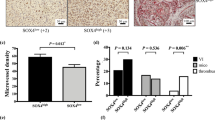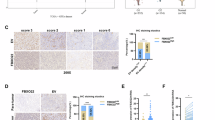Abstract
We recently report that the expression of polycomb chromobox 4 (Cbx4) is significantly correlated with the overall survival of a great cohort of hepatocellular carcinoma (HCC) patients and it enhances hypoxia-induced vascular endothelial growth factor (VEGF) expression and angiogenesis in HCC cells through enhancing sumoylation of hypoxia inducible factor-1alpha (HIF-1α). Here we continue to investigate the potential effects of Cbx4 on the migration and metastasis of the metastatic HCC cell line MHCC97L. Our results show that Cbx4 overexpression in the cell line increases the in vitro vessel formation of vascular endothelial cells in its SUMO interaction motifs-dependent manner, and promotes the in vitro migration of the cancer cell, which can be effectively abrogated by anti-VEGF antibody. Although Cbx4 expression does not impact the in vitro growth of MHCC97L cells, it still promotes the progression and metastasis of orthotopically transplanted tumors in nude mice. These results further support the role of Cbx4 as a SUMO E3 ligase in the progression and metastasis of HCC.
Article PDF
Similar content being viewed by others
Avoid common mistakes on your manuscript.
References
Schwartz YB, Pirrotta V. Polycomb silencing mechanisms and the management of genomic programmes. Nat Rev Genet, 2007, 8: 9–22
Morey L, Helin K. Polycomb group protein-mediated repression of transcription. Trends Biochem Sci, 2010, 35: 323–332
Di Croce L, Helin K. Transcriptional regulation by polycomb group proteins. Nat Struct Mol Biol, 2013, 20: 1147–1155
Su Y, Deng B, Xi R. Polycomb group genes in stem cell self-renewal: a double-edged sword. Epigenetics, 2011, 6: 16–19
Levine SS, King IF, Kingston RE. Division of labor in polycomb group repression. Trends Biochem Sci, 2004, 29: 478–485
Au SL, Ng IO, Wong CM. Epigenetic dysregulation in hepatocellular carcinoma: focus on polycomb group proteins. Front Med, 2013, 7: 231–241
Radulovic V, de Haan G, Klauke K. Polycomb-group proteins in hematopoietic stem cell regulation and hematopoietic neoplasms. Leukemia, 2013, 27: 523–533
Richly H, Aloia L, Di Croce L. Roles of the polycomb group proteins in stem cells and cancer. Cell Death Dis, 2011, 2: e204
Wotton D, Merrill JC. Pc2 and sumoylation. Biochem Soc Trans, 2007, 35: 1401–1404
Kagey MH, Melhuish TA, Wotton D. The polycomb protein Pc2 is a SUMO E3. Cell, 2003, 113: 127–137
Long J, Zuo D, Park M. Pc2-mediated sumoylation of Smad-interacting protein 1 attenuates transcriptional repression of E-cadherin. J Biol Chem, 2005, 280: 35477–35489
Li B, Zhou J, Liu P, Hu J, Jin H, Shimono Y, Takahashi M, Xu G. Polycomb protein Cbx4 promotes SUMO modification of de novo DNA methyltransferase Dnmt3a. Biochem J, 2007, 405: 369–378
Klein UR, Nigg EA. SUMO-dependent regulation of centrin-2. J Cell Sci, 2009, 122: 3312–3321
Roscic A, Moller A, Calzado MA, Renner F, Wimmer VC, Gresko E, Ludi KS, Schmitz ML. Phosphorylation-dependent control of Pc2 SUMO E3 ligase activity by its substrate protein HIPK2. Mol Cell, 2006, 24: 77–89
Fischle W, Wang Y, Jacobs SA, Kim Y, Allis CD, Khorasanizadeh S. Molecular basis for the discrimination of repressive methyl-lysine marks in histone H3 by Polycomb and HP1 chromodomains. Genes Dev, 2003, 17: 1870–1881
Merrill JC, Melhuish TA, Kagey MH, Yang SH, Sharrocks AD, Wotton D. A role for non-covalent SUMO interaction motifs in Pc2/Cbx4 E3 activity. PLoS ONE, 2010, 5: e8794
Li J, Xu Y, Long XD, Wang W, Jiao HK, Mei Z, Yin QQ, Ma LN, Zhou AW, Wang LS, Yao M, Xia Q, Chen GQ. Cbx4 governs HIF-1alpha to potentiate angiogenesis of hepatocellular carcinoma by its SUMO E3 ligase activity. Cancer Cell, 2014, 25: 118–131
Li J, Xu Y, Jiao HK, Wang W, Mei Z, Chen GQ. Regulation of hypoxia inducible factor-1alpha by SUMOylation and its signific-ances in cancers. Sci China Life Sci, 2014, in press
Cui JF, Liu YK, Zhang LJ, Shen HL, Song HY, Dai Z, Yu YL, Zhang Y, Sun RX, Chen J, Tang ZY, Yang PY. Identification of metastasis candidate proteins among HCC cell lines by comparative proteome and biological function analysis of S100A4 in metastasis in vitro. Proteomics, 2006, 6: 5953–5961
Goel HL, Mercurio AM. VEGF targets the tumour cell. Nat Rev Cancer, 2013, 13: 871–882
Roberts E, Cossigny DA, Quan GM. The role of vascular endothelial growth factor in metastatic prostate cancer to the skeleton. Prostate Cancer, 2013, 2013: 418340
Lin S, Hoffmann K, Schemmer P. Treatment of hepatocellular carcinoma: a systematic review. Liver Cancer, 2012, 1: 144–158
Pang R, Poon RT. Angiogenesis and antiangiogenic therapy in hepatocellular carcinoma. Cancer Lett, 2006, 242: 151–167
Zhu AX, Duda DG, Sahani DV, Jain RK. HCC and angiogenesis: possible targets and future directions. Nat Rev Clin Oncol, 2011, 8: 292–301
Fang P, Hu JH, Cheng ZG, Liu ZF, Wang JL, Jiao SC. Efficacy and safety of bevacizumab for the treatment of advanced hepatocellular carcinoma: a systematic review of phase II trials. PLoS ONE, 2012, 7: e49717
Di Marco V, De Vita F, Koskinas J, Semela D, Toniutto P, Verslype C. Sorafenib: from literature to clinical practice. Ann Oncol, 2013, 24(Suppl 2): II30–37
Semenza GL. Defining the role of hypoxia-inducible factor 1 in cancer biology and therapeutics. Oncogene, 2010, 29: 625–634
Pugh CW, Ratcliffe PJ. Regulation of angiogenesis by hypoxia: role of the HIF system. Nat Med, 2003, 9: 677–684
Liu B, Liu YF, Du YR, Mardaryev AN, Yang W, Chen H, Xu ZM, Xu CQ, Zhang XR, Botchkarev VA, Zhang Y, Xu GL. Cbx4 regulates the proliferation of thymic epithelial cells and thymus function. Development, 2013, 140: 780–788
Luis NM, Morey L, Mejetta S, Pascual G, Janich P, Kuebler B, Cozutto L, Roma G, Nascimento E, Frye M, Di Croce L, Benitah SA. Regulation of human epidermal stem cell proliferation and senescence requires polycomb-dependent and -independent functions of Cbx4. Cell Stem Cell, 2011, 9: 233–246
Wang B, Tang J, Liao D, Wang G, Zhang M, Sang Y, Cao J, Wu Y, Zhang R, Li S, Ding W, Zhang G, Kang T. Chromobox homolog 4 is correlated with prognosis and tumor cell growth in hepatocellular carcinoma. Ann Surg Oncol, 2013, 20(Suppl 3): S684–692
Author information
Authors and Affiliations
Corresponding author
Additional information
This article is published with open access at link.springer.com
Rights and permissions
Open Access This article is distributed under the terms of the Creative Commons Attribution 4.0 International License (https://creativecommons.org/licenses/by/4.0), which permits use, duplication, adaptation, distribution, and reproduction in any medium or format, as long as you give appropriate credit to the original author(s) and the source, provide a link to the Creative Commons license, and indicate if changes were made.
About this article
Cite this article
Mei, Z., Jiao, H., Wang, W. et al. Polycomb chromobox 4 enhances migration and pulmonary metastasis of hepatocellular carcinoma cell line MHCC97L. Sci. China Life Sci. 57, 610–617 (2014). https://doi.org/10.1007/s11427-014-4663-9
Received:
Accepted:
Published:
Issue Date:
DOI: https://doi.org/10.1007/s11427-014-4663-9




